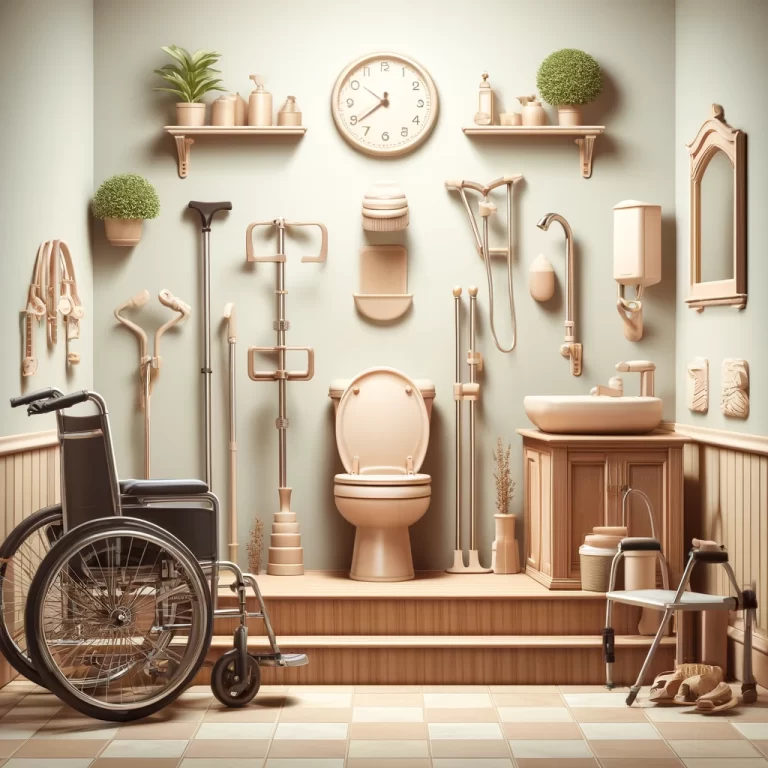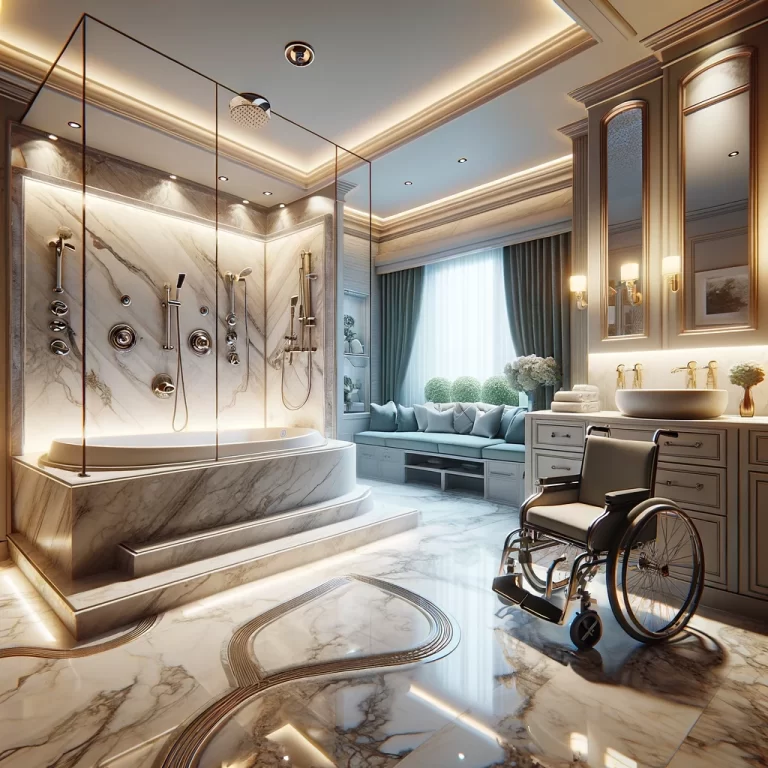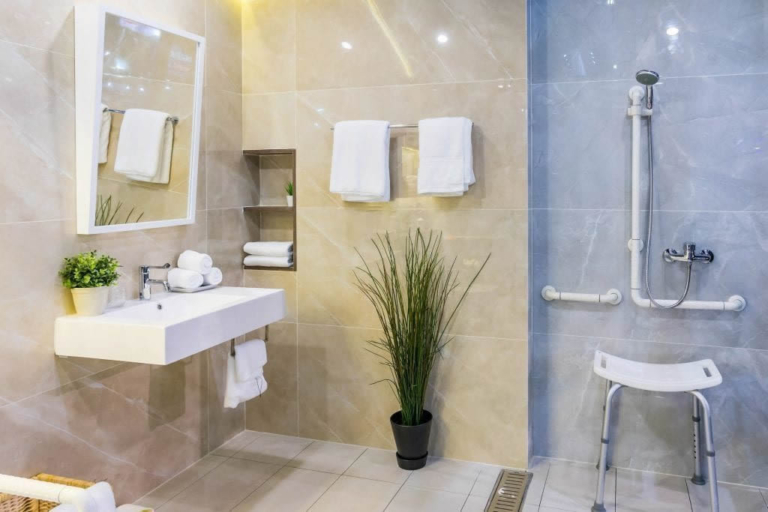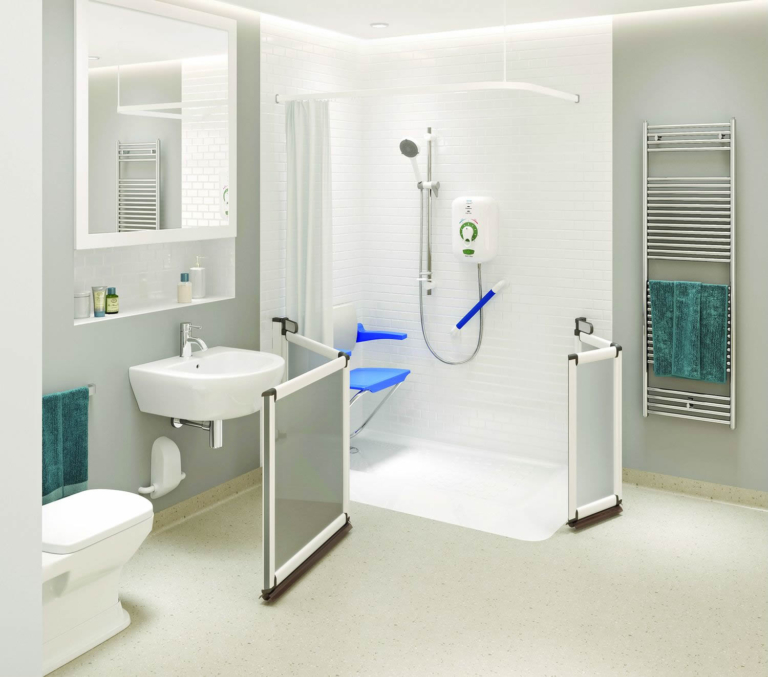How much does it cost to rip and replace a mobility bathroom
If you or a loved one is facing mobility issues, a mobility bathroom could make a significant difference.
We will look into the typical issues with mobility bathrooms, the cost of installing one, the various choices accessible, and the procedure involved.
Discover more about the factors influencing costs, additional expenses to bear in mind, and the necessary steps for a successful renovation.
What Is a Mobility Bathroom?
A mobility bathroom is a specialised bathroom designed to cater to individuals with disabilities or long-term illnesses, offering features that enhance accessibility and safety.
These bathrooms are specifically tailored to meet the needs of people with mobility challenges, providing various adaptations such as grab bars strategically placed around the toilet and shower areas, non-slip flooring to prevent accidents, and wider doorways to accommodate mobility aids like wheelchairs or walkers.
Moreover, accessible sinks and countertops are designed at lower heights for wheelchair users, and lever-style taps ensure easy operation for those with limited hand dexterity. Roll-in showers with fold-down seats and handheld showerheads allow for greater independence and comfort when bathing.

What Are the Benefits of Having a Mobility Bathroom?
Having a mobility bathroom comes with numerous benefits, including improved accessibility, enhanced safety features, and potential increases in property value.
For individuals with reduced mobility, the convenience and ease of access that a mobility bathroom offers can significantly enhance their daily living experience. Simple tasks like showering or using the toilet become smoother and more manageable, promoting independence and boosting overall well-being. The incorporation of safety features such as grab rails, non-slip flooring, and walk-in showers not only reduces the risk of accidents but also provides peace of mind to both the user and their loved ones.
The installation of a mobility bathroom is seen as a desirable feature by potential buyers, thereby potentially increasing the resale value of a property. This additional selling point can attract a wider range of prospective homeowners, leading to a competitive edge in the property market. Investing in a mobility bathroom is not just about meeting accessibility needs but also about enhancing comfort, promoting safety, and maximising the property’s appeal and value.
What Are the Signs That You Need to Replace Your Mobility Bathroom?
Recognising the signs that indicate the need to replace your mobility bathroom is crucial for maintaining safety, functionality, and aesthetics in your living space.
One of the most common indicators that it’s time to renovate or replace a mobility bathroom is wear and tear, visible in cracked tiles, chipped fixtures, or leaking pipes. These issues not only affect the appearance but can also pose safety risks and lead to further damage if left unaddressed. Outdated features in a mobility bathroom can hinder accessibility and convenience for individuals with mobility challenges.
Timely renovation projects are essential to ensure that your bathroom remains a functional and safe space for all users.”
What Are the Common Problems with Mobility Bathrooms?
Common problems with mobility bathrooms can range from issues with accessibility fittings to concerns about the quality of materials and their associated costs.
One prevalent challenge faced by individuals with mobility bathrooms is the frequent malfunctioning of grab rails, shower seats, and handheld shower heads, which are essential for safe and comfortable use. This not only poses a risk for users but also necessitates timely repairs or replacements, adding to the maintenance costs. Inferior materials used in the construction of these bathrooms may lead to issues like leaks, cracks, or discolouration over time, requiring expensive renovations to ensure durability and aesthetics.
How Much Does It Cost to Replace a Mobility Bathroom?
The cost of replacing a mobility bathroom varies depending on factors such as the scope of the project, the quality of materials, installation requirements, and any additional features or adaptations needed.
In terms of budgeting for a mobility bathroom replacement, homeowners need to take into account the price of materials, which can range from standard to high-end, affecting the overall cost significantly. Labour costs also play a crucial role, as skilled professionals may charge more for specialised installation of accessible features like grab rails, non-slip flooring, and ADA-compliant fixtures. Any structural modifications required for the bathroom layout to accommodate mobility aids or widen doorways may add to the expenses. It is important to factor in these various cost aspects to ensure a successful and budget-friendly bathroom renovation project.
What Factors Affect the Cost of Replacing a Mobility Bathroom?
Several key factors can influence the cost of replacing a mobility bathroom, including the choice of materials, the extent of labour required, any additional adaptations for accessibility, and the overall design complexity.
- When selecting materials, options range from basic to high-end selections, each significantly impacting the final price point. Material quality is a crucial determinant – consider factors such as durability, water resistance, and maintenance requirements.
- Labour expenses can vary depending on the scope of work involved, with intricate installations or custom features often necessitating higher costs. Accessibility upgrades, such as grab bars, non-slip flooring, and widened doorways, may require additional investment but are essential for creating a safe and functional space for individuals with mobility challenges.
What Are the Different Options for Replacing a Mobility Bathroom?
When considering replacing a mobility bathroom, homeowners have various options available, ranging from full-scale renovations to targeted upgrades that enhance accessibility and functionality.
Full-scale renovations involve completely redesigning the bathroom layout to optimise space and ease of movement. This may include replacing fixtures, expanding doorways, installing grab bars, and incorporating non-slip flooring.
On the other hand, partial upgrades focus on specific areas that require attention, such as installing a walk-in shower or a bath with a door for easier access. These modifications can make a significant difference in improving safety and convenience.
Specific adaptations, like adding a raised toilet seat, grab rails, or a shower seat, are tailored solutions that cater to unique mobility needs. These targeted changes are often cost-effective and quickly enhance the bathroom’s usability for individuals with disabilities or limited mobility.
What Is the Process for Replacing a Mobility Bathroom?
The process of replacing a mobility bathroom typically involves several steps, from assessing your needs and budget to the final installation of new mobility features and finishing touches.
- After assessing your needs and budget, the next step involves considering the design layout of the bathroom to ensure optimal accessibility and functionality.
- Once the design is finalised, the demolition phase begins, where old fixtures, flooring, and any existing structures are removed to make way for the new features.
- Subsequently, the installation of accessibility features like grab rails, shower seats, and non-slip flooring takes place to enhance safety and convenience.
- The completion process involves adding final touches such as decorative elements, lighting fixtures, and ensuring everything meets the necessary building codes.
Step 1: Assessing Your Needs and Budget
The initial step in replacing a mobility bathroom is to assess your specific requirements, including mobility needs, design preferences, and establishing a realistic budget that aligns with the renovation cost.
Considering individual needs is crucial as it ensures that the new bathroom layout enhances comfort and functionality. By evaluating the financial constraints early on, you can tailor the renovation project to suit your budget without compromising on quality. Proper cost projections help in estimating expenses accurately, preventing unexpected financial burdens during the renovation process.
Step 2: Designing Your New Mobility Bathroom
Designing your new mobility bathroom involves selecting appropriate fittings, materials, and layout configurations that prioritize accessibility, safety, and aesthetic appeal in line with your specific requirements.
When choosing materials for your mobility bathroom, it is essential to consider factors such as durability, ease of maintenance, and slip resistance. Opt for non-slip flooring options like textured tiles or vinyl to prevent accidents. Select fittings with grab rails, adjustable showerheads, and wider doorways to accommodate mobility aids. The layout should be spacious to allow for maneuverability, with the toilet and shower area easily accessible. Proper lighting and color schemes can also enhance the overall look and feel of the space, creating a welcoming and functional environment.
Step 3: Demolition and Removal of Old Bathroom
The demolition phase involves the removal of existing fixtures, fittings, and structures in the old mobility bathroom to prepare the space for the installation of new accessibility features and enhancements.
During this crucial stage, professionals carefully dismantle and haul away the outdated components, such as sinks, toilets, cabinets, and tiles. The disposal of these materials requires adherence to local regulations regarding hazardous waste and recycling guidelines.
Structural modifications may also be necessary to accommodate the new layout and fixtures. This can involve adjusting plumbing and electrical systems to meet code requirements, reinforcing walls for added support, and creating a seamless foundation for the upcoming renovations.
Step 4: Installation of New Mobility Features
The installation phase focuses on fitting new mobility features, such as grab bars, handrails, and specialised bathroom taps, to enhance accessibility and usability according to the design plan.
Grab bars are strategically placed near the toilet, shower areas, and bath to provide support and stability for individuals with mobility challenges. Handrails are installed along walls to assist in moving around the bathroom safely. The specialised bathroom taps are lever or touch-controlled to make them easier to operate for people with limited dexterity.
Shower seats and adjustable-height showerheads are added to cater to various user needs. Non-slip flooring options are integrated to prevent accidents. The layout is carefully designed to offer ample space for wheelchair users to maneuver comfortably.
Step 5: Finishing Touches and Clean Up
The final step involves adding finishing touches to the newly installed mobility bathroom, ensuring that all elements are properly integrated, functional, and aesthetically pleasing, followed by a thorough clean-up of the workspace.
During the finishing touches phase, a skilled team meticulously inspects the bathroom to guarantee that each fixture and component seamlessly fits together. They focus on details like ensuring the grab bars are securely installed, the non-slip flooring is correctly laid, and the raised toilet seat is at the right height for the user.
Labour requirements during this phase may vary depending on the complexity of the project. Experienced plumbers, electricians, and carpenters collaborate to ensure all aspects of the bathroom are functioning correctly.
Post-renovation, the team dedicates time to tidying up the area thoroughly. They dispose of any waste materials responsibly, clean all surfaces, and leave the space spotless for the homeowner to enjoy.
Are There Any Additional Costs to Consider?
Along with the direct replacement costs, there are several additional expenses to consider when upgrading a mobility bathroom, such as permits, professional contractor fees, plumbing, electrical work, materials, and labour.
Obtaining necessary permits for the renovation project is a crucial step that might incur extra costs depending on the location and scope of work. Professional contractor fees can vary based on experience and reputation, impacting the overall budget significantly. Plumbing and electrical services are essential components of a bathroom remodel, adding to the financial outlay. Material expenditures, ranging from tiles to fixtures, contribute to the total expenses. Labour charges, often calculated by project duration or hourly rates, form a substantial part of the supplementary costs.
Cost of Permits and Inspections
Obtaining licences and undergoing necessary checks are essential steps that may incur additional costs during the process of replacing a mobility bathroom, but they are crucial for compliance and safety standards.
Licences and checks play a vital role in ensuring that the modifications made to a mobility bathroom meet all building codes and accessibility requirements. This oversight helps in safeguarding the well-being of individuals using the facilities, especially those with mobility challenges.
Along with adhering to regulations, acquiring licences and scheduling checks can aid in identifying potential issues early on, preventing costly rework or modifications down the line. Whilst the process might seem bureaucratic, it is designed to uphold the quality and safety of the project.
Cost of Hiring a Professional Contractor
Engaging a professional contractor for the replacement of a mobility bathroom involves costs related to labour, expertise, and quality craftsmanship, ensuring the successful completion of the renovation project.
Professional contractors play a crucial role in mobility bathroom replacements as they bring specialised skills and experience to the table, ensuring that the project is executed with precision and efficiency. Skilled tradespeople handle various tasks such as plumbing, electrical work, tiling, and fixture installation, guaranteeing that every aspect of the renovation meets industry standards and safety requirements.
Whilst it is true that the services of contractors come with a cost, the value they provide is unmatched. Their expertise not only results in a beautifully renovated bathroom but also adds to the overall functionality and accessibility of the space, especially in the case of mobility bathrooms designed for individuals with specific needs.
Cost of Plumbing and Electrical Work
The expenses associated with plumbing and electrical work in mobility bathroom replacements reflect the complexity of these installations and the necessity of professional expertise to ensure safety and functionality.
In terms of plumbing services in a mobility bathroom, costs can vary based on the specific needs of the space. Factors such as the layout, fixtures required, piping materials, and accessibility can all influence the overall budget. Skilled plumbers will assess the existing plumbing system, carry out any necessary modifications, and install efficient fixtures like grab bars and adapted sinks to meet the unique needs of individuals with mobility challenges.
Similarly, electrical work for mobility bathrooms demands attention to detail and compliance with safety regulations. Costs may include rewiring, installing specialised lighting for better visibility, and ensuring power outlets are conveniently located for easy access. Professional electricians will guarantee that all electrical components are installed correctly and take into account the specific requirements for mobility aids and equipment.
Cost of Materials and Fixtures
The selection of materials and fixtures for a mobility bathroom replacement directly impacts the overall renovation cost, with choices ranging from basic, budget-friendly options to premium, high-quality selections.
When embarking on a mobility bathroom project, it’s essential to carefully consider the cost implications of each material and fixture choice. Opting for high-quality materials may require a larger upfront investment, but their durability and longevity often prove more cost-effective in the long run. The design aspects cannot be overlooked, as the chosen fixtures and materials not only need to enhance accessibility but also harmonize with the overall aesthetic of the bathroom.
Cost of Labour and Installation
Labour costs for installing mobility bathroom features encompass skilled workmanship, time requirements, and the expertise needed to ensure proper installation and functionality, contributing significantly to the overall project expenses.
Professional installation services provide peace of mind for homeowners as experienced installers can navigate the intricate process efficiently and effectively, ensuring that every safety feature is correctly positioned.
The complexities involved in installing grab bars, shower seats, and other mobility aids require meticulous attention to detail and adherence to strict guidelines to guarantee functionality and durability over time.
This specialised labour not only adds to the overall expense but also plays a crucial role in the final results, determining the quality and longevity of the newly installed bathroom features.
Frequently Asked Questions
How much does it cost to rip and replace a mobility bathroom?
The cost of ripping and replacing a mobility bathroom can vary depending on a few factors. This includes the size of the bathroom, the materials used, and any additional accommodations needed. On average, you can expect to spend anywhere from £5,000 to £15,000 for a complete rip and replace project.
What factors can impact the cost of ripping and replacing a mobility bathroom?
As mentioned, the size of the bathroom and the materials used are two key factors that can impact the cost of a rip and replace project. However, other factors such as the location of the bathroom, accessibility needs, and the complexity of the project can also affect the overall cost.
Are there any additional costs to consider when ripping and replacing a mobility bathroom?
In addition to the cost of materials and labour, there may be other expenses to consider when planning for a rip and replace project. This can include permits, plumbing and electrical work, and any necessary modifications for mobility aids such as grab bars or handrails.
Can I get a cost estimate before starting a rip and replace project?
Yes, it is recommended to get a cost estimate from a contractor before starting any rip and replace project. This will give you a better understanding of the total cost and allow you to budget accordingly. It is also important to get multiple estimates and compare them to ensure you are getting the best deal.
Are there any financing options available for ripping and replacing a mobility bathroom?
Depending on your location and personal situation, there may be financing options available for a rip and replace project. This can include government assistance programs, home improvement loans, or special financing from contractors. It is best to research and inquire about these options before beginning the project.
Can I make any cost-saving choices when ripping and replacing a mobility bathroom?
Yes, there are a few ways to potentially save on the cost of a rip and replace project. This can include choosing more affordable materials, opting for a simpler design, and doing some of the work yourself if you have the necessary skills. However, it is important to balance cost-saving measures with the overall quality and safety of the project.







